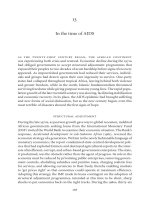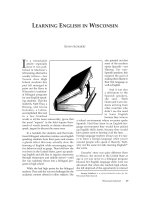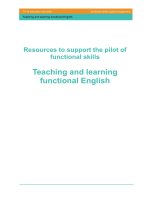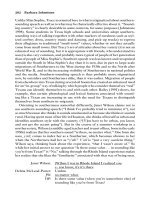Learning Spoken English in Half the Time
Bạn đang xem bản rút gọn của tài liệu. Xem và tải ngay bản đầy đủ của tài liệu tại đây (1.45 MB, 84 trang )
1
2
Index:
Introduction
Chapter 1: Teaching Your Tongue to Speak English 1
Chapter 2: Four Rules for Learning Spoken English 12
Chapter 3: Grammar and Writing in Spoken English
Study 17
Chapter 4: Do You Need Beginning and Advanced
Lessons? 21
Chapter 5: Selecting a Text 25
Chapter 6: Studying the English Verb 35
Chapter 7: Success in Spoken English Study 43
3
Lynn Lundquist is the developer of both Spoken English
Learned Quickly and the Proprioceptive Language
Learning Method (also known as the Feedback Training
Method). For the same amount of study time, students
using this method with the Spoken English Learned
Quickly lessons can learn to speak English in half the time
it would require when using other English language
courses. Just two years after it was introduced on
www.FreeEnglishNow.com, Spoken English Learned
Quickly became the world's most widely distributed
spoken English language course.
Lundquist has an undergraduate degree in both
Anthropology and Education, and a Master's degree in
Education. Following graduation, he studied French in
Paris, France for a year where he first became acquainted
with spoken language instruction. He then lived in an
African country for nine years where he developed his
own language course because little was available in the
local schools. During the time he was learning his second
language, he developed many of the methods he describes
in this book, Learning Spoken English. He has the
personal experience of learning languages and also knows
4
the frustration of being regarded as "stupid" because he
could not speak a new language well.
Lundquist has done considerable innovative work. He
has 14 published books (in the fields of electrical training,
ancient Greek manuscript exploration, and English
language study). He is a licensed, supervising electrician
and holds 23 issued U.S. patents in the field of industrial
equipment and processes.
Most recently, he spent five years developing both the
Spoken English Learned Quickly language course and
the instruction method known as the Proprioceptive
Method.
5
Chapter 1: Teaching Your Tongue to Speak
English
If you want to learn to speak English fluently, it will
help you to understand how the human mind produces
speech.
However, before looking at the mechanics of speech,
I want to draw an analogy from machine control because the
analogy closely parallels neurological responses in spoken
language.
Open-loop machine control
Wikipedia describes an open-loop control system as
follows:
An open-loop controller, also called
a non-feedback controller, is a type of
controller which computes its input into
a system using only the current state .
. . of the system. A characteristic of
the open-loop controller is that it does
not use feedback to determine if its
input has achieved the desired goal.
6
This means that the system does not
observe the output of the processes that
it is controlling. Consequently, a true
open-loop system . . . cannot correct
any errors that it could make.
For example, a sprinkler system,
programmed to turn on at set times could
be an example of an open-loop system if
it does not measure soil moisture as a
form of feedback. Even if rain is
pouring down on the lawn, the sprinkler
system would activate on schedule,
wasting water.
Figure 1 shows an open-loop control system. The control
may be a simple switch, or it could be a combination of a switch
and a timer. Yet, all it can do is turn the machine on. It cannot
respond to anything the machine is doing.
Open-Loop
Control
Con
t
r
o
l
Figure 1: An open-loop machine control.
7
Wate
r
p
i
p
e
Sprink
ler
he
ad
T
i
m
e
r
V
a
l
v
e
Soil moisture
probe
Figure 2: A closed-loop sprinkler
system.
Closed-loop machine control
Wikipedia then describes closed-loop control as follows:
To avoid the problems of the open-loop
controller, control theory introduces
feedback. A closed-loop controller uses
feedback to control states or outputs of
a dynamical system. Its name comes from
the information path in the system:
process inputs (e.g. voltage applied to
a
motor) have an effect on the process
outputs (e.g. velocity . . . of the
motor), which is measured with sensors
and processed by the controller; the
result (the control signal) is used as
input to the process, closing the loop.
8
Wikipedia's definition of a closed-loop system subsequently
becomes too technical to use here. However, as Wikipedia
suggests above, a sprinkler incorporating a soil moisture
sensor would be a simple closed-loop system. The sprinkler
system would have both a timer and a control valve. Either
could operate independently, and either could shut the water
off, but both would need to be open in order for the sprinkler
to operate. The arrangement is shown in Figure 2.
If the soil is already moist, the sprinkler will remain off
whether or not the timer is open. When the moisture probe
senses dry
soil, the
valve is
opened. However, after the sprinkler is on, if the soil becomes
moist enough, the valve will close even if the timer is still
open. Thus, the sprinkler uses feedback from its own
operation to control itself.
Figure 3 shows a simple closed-loop machine control.
Co
n
t
r
o
l
Feed
b
a
c
k
Closed-Loop
Control
Calibra
tio
n
Figure 3: A closed-loop machine
control.
9
Notice that Figure 3 also shows a calibration function.
Irrespective of whether it is a soil moisture sensor on a
sprinkler—or a counter on a machine—there must be some
way of setting the control so that it will respond in a
predetermined way. In a machine application, the calibration
function could be a counter which is set so that the machine
will produce a certain number of finished parts.
Human speech is a closed-loop system
Human speech is a complex learned skill and is
dependent on a number of memory and neurological
functions. Speech is a closed-loop system because sensors
within the system itself give feedback to the control portion of
the system. The control then corrects and coordinates ongoing
speech. In this case, the mind is in control of the closed-loop
system, the mouth produces the desired product (speech), and
auditory feedback from the ears and feedback from the nerve
sensors in the mouth allow the mind to coordinate the speech
process in real time.[1]
When you speak your own language, your mind stores
all of the vocabulary you need. Your mind also controls your
tongue, mouth, and breathing. Your hearing is also an
important part of the control because your ears hear
everything your mouth says. Therefore, what you say next is
partially dependent on the vocabulary and other information
10
stored in your mind. But what you say next is also dependent
on what your ears are hearing your mouth say, and on the
feedback that is coming from the nerves in your tongue and
mouth.
Because you have spoken your own language all of
your life, all of this control is automatic—you do not need to
think about it. But when you learn to speak English, you must
retrain all of these processes so that they will all work together
at the same time. It is not enough to simply put new
vocabulary words or grammar drills into your memory. You
must retrain your mind to use all of the new sounds your ears
will hear, as well as the new movements of your tongue,
mouth, and breathing. Yet, since all of these things must
happen together for you to speak fluent English, all retraining
of your memory, hearing, and the nerves in your mouth must
be done simultaneously.
Proprioceptive.[2] Human speech would be impossible
without the proprioceptive sense. (Proprioceptive refers to the
sense within the organism itself which detects or controls the
movement and location of the muscles, tendons, and joints
which are used to create speech.) Our mouth, vocal cords,
diaphragm, and lungs incorporate thousands of nerve sensors
which the brain uses to control the movement and position of
these same organs—the mouth, vocal cords, diaphragm, and
11
lungs. Imagine the complexity of pronouncing even a single
word with the need to coordinate the tongue, breath control,
and jaw muscles. Now multiply this complexity exponentially
as sentences are constructed in rapid succession during normal
speech.
Real time. Unlike an open-loop control system, a closed-
loop control system monitors feedback and corrects the
process as the machine is running. The reciprocal path
between the control, the feedback sensors, and the process
itself is instantaneous. That is, information is not stored for
later use. Rather, it is used instantaneously as the sensors
detect it. In this chapter, I use the term simultaneous to indicate
real time feedback during speech.
Calibration. In human speech, the mind must constantly
monitor the feedback information from both the speaker's
own hearing and the proprioceptive senses which enable the
mind to control muscles and create the desired sounds. Thus,
the speaker is constantly "calibrating" the feedback to control
speech. To change a tense, the speaker may change "run" to
"ran," or change the person from "he" to "she," and so on.
These "word" changes are achieved by precise control of the
muscles used to produce speech.
We "calibrate" our speech frequently as we talk. This is
why we can misuse a word, verb tense, or some other part of
12
the initial sentence, and still make corrections in the remaining
words of the sentence so that the listener does not hear our
mistake.
Thus, in Figure 4, human speech is represented as the
interplay between the mind, the mouth, and its related organs
(represented in the figure by the tongue), two feedback
systems, and conscious calibration as the speaker constructs
each sentence. In addition, calibration is continuously taking
place within the control center—the mind. However, because
it is acting on feedback from hearing and the proprioceptive
senses, I am showing calibration as acting on the source of the
feedback.
When children learn their mother tongue, their natural
ability to hear and mimic adult speech builds complex
proprioceptive response patterns. A French-speaking child
effortlessly learns to make nasal sounds. An English-speaking
child learns to put her tongue between her teeth and make the
"th" sound. A Chinese-speaking child learns to mimic the
important tones which change the meaning of words. Each of
these unique sounds requires learned muscle control within
the mouth.
I make no apology for the intricacy of this explanation.
The neurological feedback and resulting control of the muscles
involved in speech is extremely complex. The mind is involved
13
Control and Feedback in Human
Speech
Feedba
ck
Feed
b
a
c
k
Recali
br
at
e
C
o
n
t
r
o
l
Recali
br
ate
Figure 4: Control and feedback in human speech.
in a far greater task than simply remembering vocabulary and
organizing words into meaningful sentences.
If you are learning English as a new language, all of its
unique sounds and syntax must be learned. This is much more
than a memory function involving just your mind. Each of
these new sound and syntax patterns requires retraining your
entire mind, the nerve feedback in your tongue, mouth, and
breathing (which is proprioceptive feedback), and the auditory
feedback (your sense of hearing).
Even English syntax is dependent on your proprioceptive
sense. The statement, "This is a book," feels different to the
14
nerve receptors in your mouth than the question, "Is this a
book?" We can certainly understand that memory is involved
in the use of correct grammar. Just as important, however, is
the observation that proprioceptive feedback demands that a
question evoke a different sequence of feedback than a
statement. This is why I have identified partial syntax control
in Table 1 as being a shared function of both the mind
(memory) and the mouth (as a proprioceptive sense).
If you doubt that the proprioceptive sense is an important
part of speech, try this experiment. Read two or three
sentences written in your own language. Read it entirely in
your mind without moving your lips. You may even speed
read it. Now read the same sentences "silently" by moving
your lips without making any sound. Your mind will respond
to the first way of reading as simple information which is
primarily a memory function, but will respond to the second
way as speech because of the proprioceptive feedback from
your mouth.
Did you also notice a difference between the two readings
in terms of your mental intensity? The first reading would elicit
the mental activity required when you do a written grammar-
based English assignment. The second would result in the
same kind of mental activity required when you study English
using spoken drills. How quickly you learn to speak fluent
15
English will be directly proportional to your mental
involvement when you study.
The best way to learn English
Two skill areas must be emphasized if you want to
learn to speak English fluently. The first is memory (which is
involved in both vocabulary and syntax) and the second is
proprioceptive responses (which are involved in both
pronunciation and syntax).
You may be able to learn simple vocabulary-related
memory skills with equal effectiveness by using either verbal
or visual training methods. That is, you may be able to learn
pure memory skills equally well with either spoken drills or
written exercises.
However, it is impossible for you to retrain your
proprioceptive sense without hearing your own voice at full
speaking volume. Thus, in my opinion, it is a waste of your
time to do written assignments for the purpose of learning
spoken English.
Surprisingly, it will take far less time for you to learn
both fluent spoken English and excellent English grammar by
studying only spoken English first, than it will for you to study
written English grammar lessons before you can speak
16
Control and Feedback
Training
Must be
Simultaneous
Fee
d
b
a
c
k
Recal
i
b
r
a
t
e
C
o
n
t
r
o
l
T
i
m
e
0
Figure 5: Control and feedback
training
must be
simultaneous.
English. This does not mean, however, that grammar is not a
necessary part of
spoken English
instruction. It is
impossible to speak
English—or any
other language—
without correct use
of its grammar. My
statement simply
means that the best
way to learn English
grammar is through
spoken English
exercises. (See
Chapter 3: Grammar
and Writing in Spoken
English Study.)
Inasmuch as
spoken English
involves multiple
areas of skill working
cooperatively in real
time, it is mandatory
17
that effective spoken English teaching methods simultaneously
train all of these areas of speech. This is shown in Figure 5.
It is the important area of the proprioceptive sense
which has been most overlooked in current grammar-based
teaching methodology. When any student over the age of
about 12 attempts to learn a spoken language, his or her
proprioceptive sense must be consciously retrained for all of
the new sounds and syntax.
Furthermore, to properly retrain the proprioceptive
sense of the mouth, the combined feedback from the mouth
and hearing must be simultaneously processed in the mind.
Simply said, the student must speak out loud for optimum
spoken language learning.
Without simultaneous involvement of all skill areas of
speech, it is impossible for you to effectively retrain your
proprioceptive sense in order for you to speak fluent English.
Yet, this is exactly what grammar-based English instruction
has traditionally done by introducing grammar, listening,
writing, and reading as segregated activities. It is not surprising
that you have studied English so long in school without
learning to speak fluently.
18
Figure 6: Control and feedback training are not
simultaneous in
grammar-based English instruction.
Control and feedback training are not simultaneous in
grammar-based English Instruction. Feedback is largely
ignored. Written work is predominantly
visual memory training.
C
o
n
t
r
o
l
T
i
m
e
0
сн
о
в
а
к
н
и
г
а
у
р
о
к
les
s
o
n
=
ag
a
i
n
=
boo
k
=
C
o
n
t
r
o
l
19
Grammar-based instruction has hindered English
learning by segregating individual areas of study. This
segregation is represented in Figure 6. Grammar-based
English training has not only isolated proprioceptive training
areas so that it prevents simultaneous skill development, it has
replaced it with visual memory training by using written
assignments. Grammar-based language instruction teaches
English as though spoken English was an open-loop system.
The result for the student is that, gaining English fluency
requires far more study time, pronunciation is often faulty, and
grammar becomes more difficult to learn.
Conclusion.
Why has it taken you so long to learn to speak English
fluently?
Grammar-based English language instruction teaches as
though spoken English is primarily a function of memory.
Consequently, grammar-based English lessons emphasizes
non-verbal (written) studies of grammar, writing, reading, and
listening. All of these activities may increase recall memory for
written examinations, but they have little benefit in teaching
you to speak fluent English.
20
The only way you can effectively learn spoken English is by
using spoken English as the method of instruction. All of your
study (including English grammar) should be done by
speaking English at full voice volume for the entire study
period.
[1]
Some researchers think human speech is an open-loop
system. However, it has been shown that the human brain
does many things using both open– and closed-loop control.
As suggested in this chapter, spoken English learning would
be improved using spoken English study irrespective of
whether speech control is open- or closed-loop.
[2] The terms Proprioceptive Method and Feedback Training Method
may be used interchangeably in describing this language
learning method. An earlier term, Proprio-Kinesthetic Method,
was also used for this same language program. I will use the
term proprioceptive to describe the neurological process but
will call the language learning method the Feedback Training
Method.
21
Chapter 2: Four Rules for Learning Spoken
English
There are four simple rules you must follow when you are
learning to speak English:
1. To learn to speak English correctly, you must speak it aloud.
It is important that you speak loudly and clearly when you
are studying spoken English. You are retraining your mind to
respond to a new pattern of proprioceptive and auditory
stimuli. This can only be done when you are speaking aloud at
full volume.
One of the reasons that your English study in school
required so much time while producing such poor results is
that none of the silent study did anything to train your tongue
to speak English.
2. To learn to speak English fluently, you must think in English.
The proprioceptive sense is not all that you are retraining
when you learn spoken English. There is cognitive learning
(memory) which must also take place. Grammar-based
English instruction has emphasized cognitive learning to the
22
exclusion of retraining the proprioceptive sense. Nonetheless,
cognitive learning is an important part of learning to speak
English fluently.
For speech to occur, your mind must be actively involved
in syntax development. The more actively your mind is
involved in spoken English, the more effective the learning
process becomes.
However, just as you will hinder proprioceptive training by
trying to study silently, so you will also limit cognitive learning
by reading from a text rather than constructing the syntax in
your own mind. If you are studying English with
Spoken
English Learned Quickly
, you may use the written text
when you first study a new exercise. However, after repeating
the exercise two or three times, you must close the text and do
the exercise from recall memory as you listen to the audio
recording. You must force your mind to think in English by
using your recall memory when you are studying spoken
exercises. You cannot read from a text.
I will come back to this later in Chapter 5: Selecting a Text,
because there will be times when reading from a text such as a
newspaper is an effective language learning tool. But when
you are doing sentence responses with recorded exercises, you
must force your mind to develop the syntax by doing the
exercise without reading from a text.
23
You are not thinking in English if you are reading. Making
your mind work in order to think of the answer is an
important part of learning to speak English.
3. The more you speak English aloud, the more quickly you will learn to
speak it fluently.
Proprioceptive retraining is not instantaneous. It will
require a great deal of repetition to build the new language
patterns in your mind. As these new patterns develop, there
will be progression from a laborious, conscious effort, to
speech which is reproduced rapidly and unconsciously.
When you speak your first language, you do so with no
conscious awareness of tongue or mouth position and the air
flow through the vocal cords. In contrast, it requires
experimentation and conscious effort when you first attempt
to make an unknown discrete sound in English—this single
sound, usually represented by one letter, is called a phoneme.
Some new sounds will be relatively simple for you to make.
Others will be more difficult.
To add to the complexity, each phoneme has other
phonemes or stops adjacent to it which change its sound
slightly. (A stop is a break caused by momentarily restricting
the air flow with the tongue or throat.) For example, the
24
simple English sentence, "Why didn't that work?" may be
difficult for you to pronounce if your language does not use
the English "th" sound. But it may give you difficulty for
another reason as well. There are actually two stops in the
sentence. When properly pronounced, there is a stop between
the "n" and "t" in "didn't" and another stop between the final
"t" in "didn't" and the first "t" in "that." Even though the
sentence may be said very quickly, the two stops would make
it, "Why didn / t / that work?"
Your objective is not to be able to write the sentence,
"Why didn't that work?" accurately in English. Your goal is
not even to be able to say it just well enough so that someone
could figure out what you meant. Your objective is to be able
to say, "Why didn't that work?" so perfectly to an American
that she would think she had just been asked the question by a
fellow American.
That degree of perfection will require thousands—if not
tens of thousands—of repetitions. Therefore—to be
somewhat facetious—the more quickly you correctly repeat a
particularly difficult phoneme ten thousand times, the more
quickly you will be able to use it fluently. That is what I mean
when I say, "The more you speak English aloud, the more
quickly you will learn to speak fluently."
25
4. You must never make a mistake when you are practicing spoken
English.
When you are learning spoken English using the
Spoken
English Learned Quickly
method, you are strongly
reinforcing the learning process each time you speak.
However, when you construct a sentence incorrectly, you have
not only wasted the learning time used to construct that
sentence, but you must now invest even more time in order to
retrain your mind, mouth, and hearing in order to construct
the sentence correctly. The more you use a sentence structure
incorrectly, the longer it will take for your mind, mouth, and
hearing to identify the correct syntax.
Ideally, if you used only correct syntax and pronunciation,
you could retrain your speech in considerably less time.
Consequently, you would learn to speak fluent English more
quickly.
Yet, before you conclude that this would be impossible,
let's look at a way in which it can actually be done using the
Spoken English Learned Quickly
language course. (Well, it
can almost be done!)









